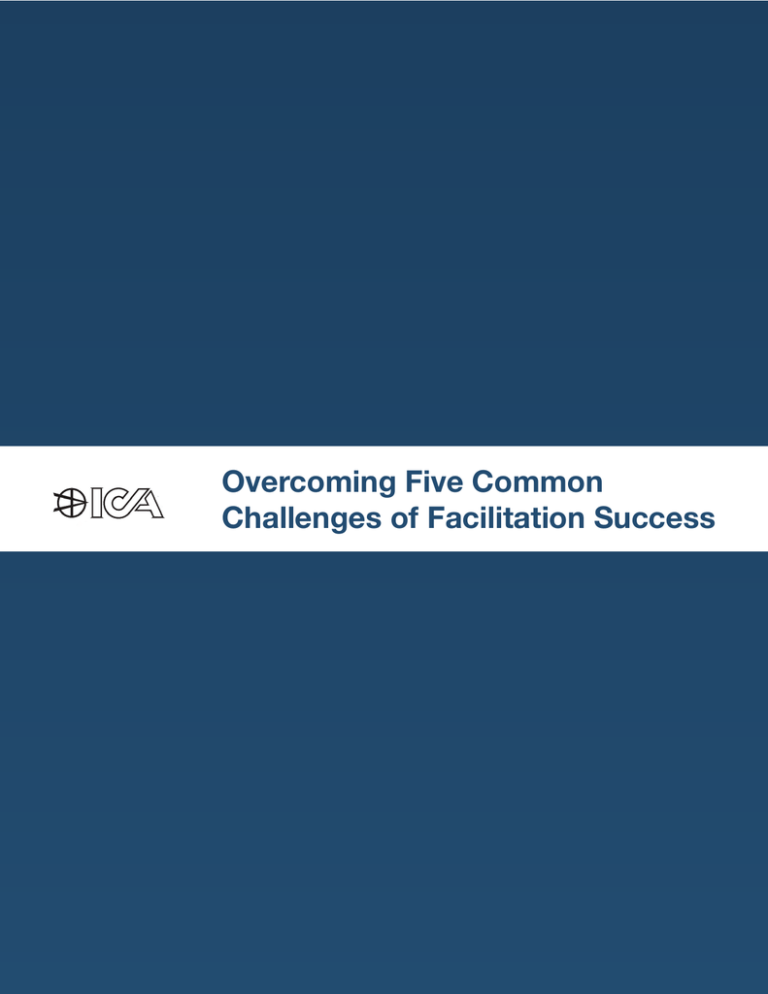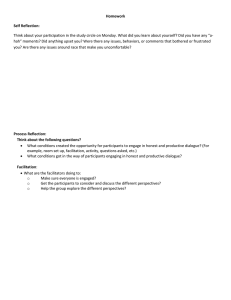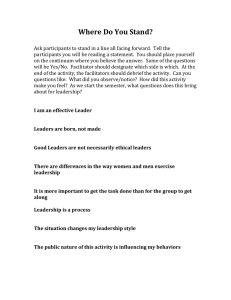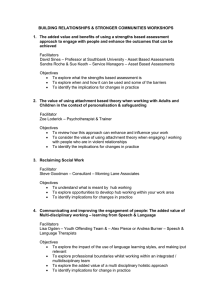Overcoming Five Common Challenges of Facilitation Success
advertisement

Overcoming Five Common Challenges of Facilitation Success W e may not realize it, but most of us are facilitators every day. If you’ve ever helped a friend or colleague solve a problem, you were a facilitator. If you’ve ever run a meeting, you were certainly acting as a facilitator. In the broadest sense, a facilitator helps others define their objectives and meet them. In the business environment, facilitators make certain that group discussions are well run and that participants reach consensus. Facilitating a group, no matter the size, can be difficult and quickly become dysfunction. To facilitate well requires training, practice, and awareness of the obstacles to success that facilitators may face, as well as knowing how to handle them. This white paper examines five of the most important elements of successful facilitation, common challenges facilitators may encounter, and suggested techniques for handling them. Develop, design, and Adjust your framework Develop, Design, and Adjust Your Framework Establishing a facilitation framework is critically important. The framework is the architecture of group facilitation— where and how it begins and ends, how it sequences subject areas, and how it handles those subjects. The framework is the foundation for the design, the working document that guides discussion. The framework defines the schedule and provides the facilitator and the group with boundaries and a procedural roadmap. The design is so important because it enables the facilitator to establish and maintain focus of the discussion areas and the time allotted to each. Meetings move more smoothly and productively when the facilitator and the participants are firmly on the same page. Even with an established framework and a working design, facilitators face the possibility of losing control of the process. Discussion can veer from the planned design, and the facilitator must be flexible enough to shift the direction of the discussion. The challenge is integrating the wayward discussion track into the original framework and steering conversation back to the design while allowing flexibility. Facilitators must use discretion in deciding the tone and tenure of the event. Too formal an approach can distance participants and dampen their involvement. Too informal Page 2 Overcoming 5 Common Challenges of Facilitation Services an approach can lessen the apparent importance of the discussion. Humor is an often used but delicate tool that is usually employed sparingly, but it is an effective tool at moments when group attention seems to waver. It’s often the case that not everyone is completely comfortable with the dynamics of the group’s interactions. This requires facilitators to exercise judgment during group interaction with a close eye to the direction of the entire gathering. Most often the tone and pace that is acceptable to the majority of the participants is most appropriate. Facilitators must steer a careful course—on the one hand they must exercise tender but firm control over the group; on the other hand the facilitator needs to recognize that the group must experience their own freedom. Avoid attention tune-out by making sure the framework includes interaction among the group. If participants must listen overly long to an overly talkative facilitator, they are less likely to remain engaged in a group discussion that has turned into lecture. The signs of group disengagement are sometimes obvious and sometimes subtle. Read body language, particularly eye contact. Determine engagement, ask questions, and measure the number and caliber of questions and comments posed by the group. The facilitator has to know whether the group is genuinely engaged. Help participants stay alert by scheduling regular breaks, offering snacks, and even considering stretching exercises to ease participants out of malaise. Depending on the group, games or puzzle exercises may be appropriate. The more involved the participants, the more likely they will enjoy the meeting, pay attention, contribute to its success, and adopt ideas that lead to final consensus. It’s important that facilitators select topics where they are knowledgeable, or at least very familiar. But it’s also important that facilitators be engaged in a learning experience of their own, unraveling contradictions and identifying new insights that facilitation is designed to uncover. When staging discussions, be certain that information is factual, unbiased, and sets the tone for open discussion and honest opinions. Be prepared to call out Page 3 Overcoming 5 Common Challenges of Facilitation Services advantages and disadvantages of discussion points and then allow the participants to reach their own conclusions. Although a detailed framework should be in place along with a carefully crafted design, it’s wise to have an alternative plan in the event discussions take a different direction than expected. This may simply include extra time at the end of the session. The future is unpredictable, but being prepared with alternative frameworks helps facilitators handle unexpected situations. Increasing involvement in facilitation groups Increasing Involvement in Facilitation Groups One proven way to begin facilitation meetings is to initiate a creative, interactive exercise with the entire group so everyone has a chance to become comfortable and involved from the very beginning. Even a simple exercise gives participants opportunities to interact with one another as well as with the facilitator. This also offers the facilitator a time to sense the general mood of the group and observe personalities. Groups always include a cross section of personalities and it can be a challenge to engage the less outgoing participants who may have important points to contribute but are reluctant to do so. Facilitators should keep a running mental list of participants’ input and strive to include those who seem reticent to speak. If the more quiet participants seem flustered to be included in the discussion when called upon, facilitators should convey that there is no penalty for their reluctance and smoothly move on to others in the group. Groups can sometimes experience the exact opposite situation—domination by strong personalities whose outspoken nature can tend to overwhelm others in the group. While others are likely to realize that one or two participants are stealing the show, so to speak, it requires tact on the part of the facilitator to see that others in the group have equal opportunities to speak out. Engaging the entire group from the beginning of the session establishes a connection among the participants and the facilitator. This is a technique used early in the session to relax the room and enable it to feel more comfortable Page 4 Overcoming 5 Common Challenges of Facilitation Services with the facilitator and fellow attendees. Warming up the atmosphere will also convey to the group that everyone, including the facilitator, is an equal and participating on an equal footing. Keep the group engaged by offering conversational anecdotes, such as humorous examples of how meetings can go wrong. Stories of ‘bad meetings’ help make everyone aware that the facilitator understands that meetings can be challenging, even frustrating, but everyone should adopt a sense of humor and fairness. This helps cement a connection between the group and the facilitator, which is essential to keeping the group engaged in the substance of the meeting. A part of this process is ensuring that the atmosphere of the meeting location itself is open and inviting. The arrangement of chairs and tables and where the facilitator stands play a subtle but important role. Round rather than oblong tables are often an appropriate venue because they avoid the appearance of a hierarchy. They also allow the facilitator to move freely around the room to encourage discussion and be face to face with everyone in the group. The more comfortable the group becomes, the more likely they are to contribute freely to the discussion. Facilitators should not be reluctant to ask the group members to clarify facts or opinions on subject matter. Facilitators are not expected to know everything, and requesting more information not only makes sure that the discussion is appropriate, it helps the facilitator appear to be on an equal footing with the group members. Facilitating events with limited preparation time Page 5 Facilitating Events with Limited Preparation Time One of the many jobs of a facilitator is setting preparations for the meeting. However, there are times when the facilitator will be requested to participate in a meeting with little or no time to prepare. The very act of accepting the task of facilitating a meeting on short notice suggests that the facilitator is at least comfortable with the topic to be discussed. Although there may not be a lot of time to prepare, the facilitator should at the very least develop a Overcoming 5 Common Challenges of Facilitation Services draft design. This sets in place a timeframe and a sense of direction for the discussion to establish control of the meeting. Even on short notice, the facilitator should begin the meeting in the same way as if there were ample time to develop the framework, compose a design, and begin the session with a review by the participants. Everyone is best served by honesty, so let the participants understand that the facilitation was recently assigned and everyone will learn as they go. Next, establish ground rules and reveal the expected outcome of the meeting. To gain insights into the group and its topic, the first design topic should draw out each participant’s goals and desired outcome. During the activity, the facilitator can observe the mix of personalities and determine how different or similar the participants appear to be. At the same time, this is an ideal opportunity for the facilitator to develop the direction the next design item will take. At every step through the draft design, be prepared to amend the direction of the discussion based upon what is learned in the session. Design items should be a mix of discussions and interactive activities. These can be alternated to help maintain variety, interest, energy, and enthusiasm, but the discussion will often take a life of its own requiring ready adaptation by the facilitator. This will also provide the facilitator the opportunity to choose the next most appropriate design topic. In fact, scheduled breaks and group activities are good opportunities to discuss possible directions with participants off line. At the meeting’s conclusion, the facilitator should probe the group on their opinions of the session and whether it met their expectations. Managing difficult group dynamics Page 6 Managing Difficult Group Dynamics The potential for challenging obstacles when facilitating are many and varied. They include personalities that may clash within the group, aggressive or unacceptable behavior by one or several participants, and overly talkative participants who may even seek to gain control of the conversation, Overcoming 5 Common Challenges of Facilitation Services which can disrupt the objectives and bring progress to a halt. No matter what the hurdle, a facilitator should handle the problem with calm professionalism and be prepared to take a step away from the discourse momentarily to assess the situation and choose the best way to steer the meeting back on course. It is important to gain general agreement on ground rules before beginning the meeting. This helps establish decorum at the outset. If distractions occur, politely remind participants of the agreed upon ground rules. If antagonistic behavior occurs—whether from a participant trying to control the discussion or one who consistently argues with the facilitator—it is the facilitator’s challenge to bring the meeting back on track. This can be as simple as purposely avoiding the participant, or taking a short intermission to ask the participant to cooperate with the larger group. Always be prepared to remind the group that the meeting demands a tight schedule to complete the design, so time—and one another’s behavior—must be respected. Maintaining interest and enthusiasm among group members Maintaining Interest and Enthusiasm Among Group Members Being well organized and having a well thought-out design are the fundamental steps in establishing and maintaining an enthusiastic group dynamic. Many meetings are so poorly run that when the word “meeting” is mentioned, most people are less than excited by the prospect. Meetings are perceived as generally disorganized, a waste of time, and difficult to sit through. As a result, as the meeting gets underway, there is often a general absence of enthusiasm. Developing and implementing an established framework and well organized design in and of themselves greatly improve the likelihood that group meetings will be better organized and more productive. As the meeting begins, the facilitator should welcome the participants, explain the purpose of the meeting, prepare the group about what should be accomplished, and convey Page 7 Overcoming 5 Common Challenges of Facilitation Services how the meeting can positively affect them. Keeping the group informed helps keep the group involved as the meeting unfolds. Very often, facilitators are advised to limit meetings to one or two topics. Too many issues can cause meetings to lose focus and confuse attendees. Too long a design runs the risk of consuming so much time that attendees’ attention may be lost. A single topic allows deeper discussion, encourages brainstorming, and increases opportunities for teamwork. Most groups welcome team activities. Most meetings result in action items and follow-ups. Facilitators should ensure that action items resulting from group decisions are properly assigned for effective implementation. Action items should be clearly reasoned and well articulated. Facilitators should first seek volunteers to carry them out before assigning them to nonvolunteers. Allowing participants to volunteer ensures better commitment. Action items convey meeting success and encourage follow-through after the session. A Final Word This white paper presents five of the most serious challenges facing facilitators and offers suggested solutions to these challenges. Like most day-to-day tasks, facilitation requires careful preparation and the ability to transition discussions to other directions while protecting the original design and the goals of the facilitation exercise. While every facilitation group is different, there are common obstacles most facilitators have encountered. Applying the methods outlined in this white paper will help facilitators to conduct more successful meetings even when unpredictable obstacles occur. Page 8 Overcoming 5 Common Challenges of Facilitation Services


